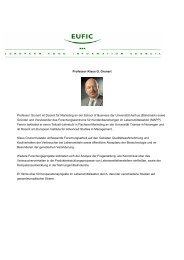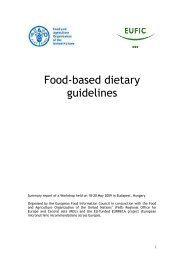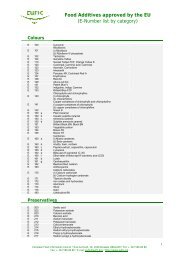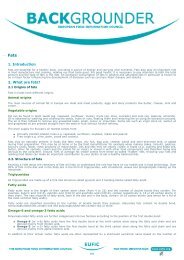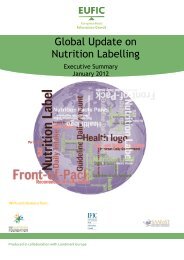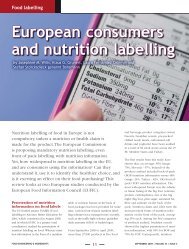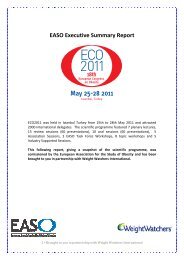pan-European research results-05-11-08 - The European Food ...
pan-European research results-05-11-08 - The European Food ...
pan-European research results-05-11-08 - The European Food ...
Create successful ePaper yourself
Turn your PDF publications into a flip-book with our unique Google optimized e-Paper software.
5 November 20<strong>08</strong><br />
<strong>European</strong> consumers spill the beans on food labels<br />
- Nutrition knowledge is generally good across Europe<br />
- Broad understanding of different types of nutrition labelling schemes<br />
- We know we should be eating more fruit and vegetables<br />
A <strong>pan</strong>-<strong>European</strong> study by the <strong>European</strong> <strong>Food</strong> Information Council (EUFIC) that will be<br />
announced at the First <strong>European</strong> <strong>Food</strong> Congress in Slovenia on 8 November, presents<br />
food for thought, for those who provide citizens with advice and support on diet and<br />
healthy lifestyles.<br />
<strong>The</strong> study, which questioned some 17,300 people in France, Germany, Hungary,<br />
Poland, Sweden and the UK, both in supermarkets and at home, found that on average<br />
only 18% of <strong>European</strong>s (ranges from 27% in UK to 9% in France) regularly look for<br />
nutrition information on food packaging in store.<br />
Independent market <strong>research</strong> agencies carried out the field work in each country.<br />
Results showed that the better established forms of nutrition information on labels such<br />
as the Guideline Daily Amount (GDA) scheme, was widely recognised and understood<br />
by shoppers.<br />
“While there are several nutrition labelling schemes across Europe, our findings show<br />
that people recognise them and generally know how to use them to make informed<br />
nutrition choices”, commented Professor Klaus Grunert of the University of Aarhus,<br />
Denmark, who conducted the study for EUFIC. “Nutrition labelling should be seen as a<br />
key element in a rounded public health strategy.”<br />
Real life in-store behaviour<br />
Among those looking for nutrition information, the Nutrition Table is the most frequently<br />
mentioned source of nutrition information in Germany, Sweden, Hungary and Poland,<br />
while more than 53% of shoppers in the UK and 44% in France looked for nutrition<br />
information in the GDA labelling system. In countries where food additives were<br />
identified as important information (Hungary, France and Poland), the ingredients table<br />
was also cited.<br />
Colour coded schemes such as traffic lights also met with high levels of awareness but<br />
were open to some misinterpretation as people tended to exaggerate the meaning of the<br />
colour-coded levels, with 73% of people believing that a ‘red’ light indicated they should<br />
avoid eating a product.<br />
Sweden, which uses a keyhole logo to identify the healthier product in a food category,<br />
had the highest awareness of any labelling system at 95%. Subjective and actual<br />
understanding of the system was also the highest, usage was lower. Notably, 61% of<br />
1
shoppers said they would look for other information even if the keyhole logo was<br />
present.<br />
Consumers were, fairly confident that they understood the labelling systems. This was<br />
well-founded, because across all countries, at least half could correctly solve a number<br />
of tasks involving interpretation of GDA and other nutrition information on labels.<br />
A new finding was that people spend an average of 30 seconds selecting a product. By<br />
comparison to previous studies, this is substantially more time than previously observed.<br />
<strong>The</strong> UK was lowest at 25 seconds per product, and Hungary the highest with a full 47<br />
seconds.<br />
Shoppers are most likely to look for nutrition information when buying yogurts, breakfast<br />
cereals and ready meals. Convenience and health clearly played a role in purchasing<br />
decisions, while taste was the most important deciding factor across all categories in<br />
most countries.<br />
Labelling of key nutrients<br />
Calories was the information most frequently sought by shoppers in four out of the six<br />
markets. However, UK consumers looked for fat content before calories, whilst Swedish<br />
consumers looked equally for sugar and fat followed by calories. Fat was among the top<br />
three in all countries as was sugar, whereas salt was in the top 5 only for Germany and<br />
the UK. Other information sought included food additives, vitamins and fibre.<br />
When given a realistic choice set of three products within the same category, including<br />
all package information, more than 70% can correctly identify the most healthy product<br />
in France, Germany, and the UK, and still about 50% in Hungary, Poland and Sweden.<br />
<strong>The</strong>se figures do not seem to be influenced by which labelling scheme is adopted on the<br />
packaging. Calories and fat levels drove healthier choices, but salt and saturated fat<br />
levels were largely ignored. Younger consumers were better at finding the right<br />
answers, and people with more nutrition knowledge gave more correct answers.<br />
Higher socio-economic status positively impacted upon looking for nutrition information<br />
and the level of nutrition knowledge.<br />
Getting it right and getting it wrong – over & under estimations<br />
When probed as to the fat, sugar or salt content of foods, the majority of respondents<br />
were able to answer correctly. On average, respondents in the UK, Hungary and<br />
Germany got 70% of the responses right, 60% in Sweden and France, and 57% in<br />
Poland.<br />
When they got the answer wrong, respondents consistently over-exaggerated actual<br />
levels. Similarly, all countries over-estimated the calorie content of alcoholic drinks.<br />
Across Europe, people tended to significantly underestimate the calories (energy)<br />
expended by everyday activities. Just 28% of Swedish and <strong>11</strong>% of Polish consumers<br />
accurately stated the number of calories expended in a brisk walk.<br />
46% or less answered correctly when asked how many calories the average adult needs<br />
per day. Women fared slightly better than men, with the lowest scores being recorded<br />
among French men – just 22% knew how many calories they should consume in one<br />
2
day, and Hungarian women – just 29% answered correctly. Most <strong>European</strong>s knew that<br />
men need more calories than women and that seniors need fewer calories, but<br />
worryingly over a third of respondents, and over half in Poland, think that children need<br />
more calories than an adult man, raising public health questions about portion sizes and<br />
over-feeding in relation to childhood obesity.<br />
Broader nutrition messages are being understood but still confusion about fats<br />
As well as probing the use and understanding of labelling, the surveys questioned<br />
peoples’ general levels of nutrition knowledge. More than 95% knew they should<br />
increase their fruit and vegetable consumption, over 73% answered correctly about<br />
eating more wholegrain (except 49% France), and over 65% about fibre.<br />
Knowledge of consuming more Omega 3 fatty acids ranged from 47% (Poland) to 88%<br />
(Sweden). However, mono-unsaturated fats and polyunsaturated fats seem less<br />
understood, with under half of all respondents correctly thinking they should consume<br />
more. Over 60% state you should eat less or try to avoid trans fat (TFA), and 68% for<br />
saturated fat.<br />
Commenting on the overall findings, Professor Klaus Grunert explained “I am surprised<br />
that the average <strong>European</strong> consumer spends 30 seconds selecting a food product.<br />
However, looking for nutrition information is not top of mind for most consumers.”<br />
Ends<br />
A webinar presentation of the <strong>results</strong> of the <strong>pan</strong>-<strong>European</strong> study by Dr Josephine Wills and<br />
Professor Klaus Grunert is available at: http://www.focusbiz.co.uk/live/eufic/mediawebinar01/<br />
For further information please contact:<br />
Laura Smillie, Communications manager, laura.smillie@eufic.org Tel. 32 2 506 89 85<br />
3



